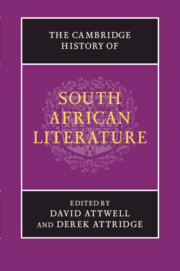Book contents
- Frontmatter
- Introduction
- PART I ORATURES, ORAL HISTORIES, ORIGINS
- PART II EXPLORATION, EARLY MODERNITY AND ENLIGHTENMENT AT THE CAPE, 1488–1820
- PART III EMPIRE, RESISTANCE AND NATIONAL BEGINNINGS, 1820–1910
- PART IV MODERNISM AND TRANSNATIONAL CULTURE, 1910–1948
- 14 Black writers and the historical novel: 1907–1948
- 15 The Dertigers and the plaasroman: two brief perspectives on Afrikaans literature
- 16 New African modernity and the New African movement
- 17 Refracted modernisms: Roy Campbell, Herbert Dhlomo, N. P. van Wyk Louw
- 18 The metropolitan and the local: Douglas Blackburn, Pauline Smith, William Plomer, Herman Charles Bosman
- PART V APARTHEID AND ITS AFTERMATH, 1948 TO THE PRESENT
- PART VI SOUTH AFRICAN LITERATURE: CONTINUITIES AND CONTRASTS
- Index
- References
18 - The metropolitan and the local: Douglas Blackburn, Pauline Smith, William Plomer, Herman Charles Bosman
from PART IV - MODERNISM AND TRANSNATIONAL CULTURE, 1910–1948
Published online by Cambridge University Press: 28 January 2012
- Frontmatter
- Introduction
- PART I ORATURES, ORAL HISTORIES, ORIGINS
- PART II EXPLORATION, EARLY MODERNITY AND ENLIGHTENMENT AT THE CAPE, 1488–1820
- PART III EMPIRE, RESISTANCE AND NATIONAL BEGINNINGS, 1820–1910
- PART IV MODERNISM AND TRANSNATIONAL CULTURE, 1910–1948
- 14 Black writers and the historical novel: 1907–1948
- 15 The Dertigers and the plaasroman: two brief perspectives on Afrikaans literature
- 16 New African modernity and the New African movement
- 17 Refracted modernisms: Roy Campbell, Herbert Dhlomo, N. P. van Wyk Louw
- 18 The metropolitan and the local: Douglas Blackburn, Pauline Smith, William Plomer, Herman Charles Bosman
- PART V APARTHEID AND ITS AFTERMATH, 1948 TO THE PRESENT
- PART VI SOUTH AFRICAN LITERATURE: CONTINUITIES AND CONTRASTS
- Index
- References
Summary
Like colonial subjects in other British colonies, South African writers have for centuries felt the tug of the metropole. Olive Schreiner went to London to seek a publisher for her African Farm, and almost without exception late nineteenth-century and early twentieth-century South African writers followed suit. This trend has continued to the present: local publishing houses established themselves firmly enough in the years that followed World War II to offer writers a viable local market, but the prestige of publication in London or New York (and other major metropolitan centres), and the global reach that this brings, sees South African writers continuing to send their manuscripts abroad.
The writers examined herewere active from the last years of the nineteenth century to the middle of the twentieth, a period that saw a decisive shift from a situation in which there was no viable alternative to being published in Britain to one in which a writer could choose. The change was remarkable: Douglas Blackburn's turn-of-the-century novels were published and reviewed in London and Edinburgh, generated some interest in the wake of the Boer War, and then vanished almost without trace; not fifty years later, Herman Charles Bosman's Mafeking Road (1947) was released by a local publisher, remaining in print and immensely popular through half a dozen local editions and innumerable impressions before finally making an inconspicuous entry into the British and American markets in 2008.
- Type
- Chapter
- Information
- The Cambridge History of South African Literature , pp. 360 - 380Publisher: Cambridge University PressPrint publication year: 2012
References
- 2
- Cited by

